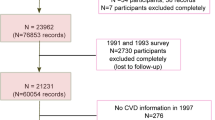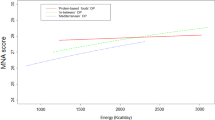Abstract
Objective: Limited inter-person variability in nutrient intake hampers epidemiologic studies of diet–disease relationships. Despite conjecture about non-traditional study bases providing large inter-person differences, virtually nothing is known about variations in nutrient intake outside of Europe and North America. The current study was conducted in India to determine sources of variability in the intakes of nutrients thought to be of public health importance.
Design: Adult subjects in Gujarat (North India; n=60) and in Kerala (South India, n=60) were administered 24 h diet recall interviews six and eight times, respectively, over a 1 y period. To assess subject (inter-person) and residual (intra-person) contributions to variance, regression models were fit to the data. From this, the variance ratio (VR, total within or intra-person: total between or inter-person) was computed.
Setting: Rural communities in North and South India.
Results: In both regions, inter-person variability was larger than that observed in the West. This was most pronounced in Gujarat, for which the VR was <1.0 for seven of the 12 energy-adjusted nutrient intakes in both men and women. In analyses of the combined data, region accounted for >20% of variance for fat, iron, copper, zinc, β-carotene and riboflavin in both men and women. With the region term removed from this model, virtually all of the variability ascribed to region contributed to inter-person variability.
Conclusions: The relatively large inter-person variability observed here could contribute to improved ‘resolution’ of diet–outcome relationships in epidemiologic studies. While this applies to data from each region, it was especially evident in analyses of the combined data.
Sponsorship: This work was supported by the Special Foreign Currency Program of the Fogarty International Center (National Institutes of Health) grant number N-406-645, a USIA Fulbright Senior Research Fellowship to Dr James R Hebert for the 1997–1998 academic year through the US Educational Foundation in India, and a UICC International Cancer Technology Transfer Fellowship (ICRETT) to Ms Hemali Mehta for collaborative work conducted with Drs Hebert and Ebbeling at the University of Massachusetts Medical School in 1998.
European Journal of Clinical Nutrition (2000) 54, 479–486
This is a preview of subscription content, access via your institution
Access options
Subscribe to this journal
Receive 12 print issues and online access
$259.00 per year
only $21.58 per issue
Buy this article
- Purchase on Springer Link
- Instant access to full article PDF
Prices may be subject to local taxes which are calculated during checkout
Similar content being viewed by others
Author information
Authors and Affiliations
Contributions
Guarantor: JR Hebert.
Contributors: JRH and PCG were responsible for the design of the study and collaborated in interpreting and writing the results. HM conducted all analyses and assisted with interpretation and writing. CBE reviewed the literature and contributed to writing and interpretation. RRB and FV implemented the field portion of the study and contributed to writing the results.
Corresponding author
Rights and permissions
About this article
Cite this article
Hebert, J., Gupta, P., Mehta, H. et al. Sources of variability in dietary intake in two distinct regions of rural India: implications for nutrition study design and interpretation. Eur J Clin Nutr 54, 479–486 (2000). https://doi.org/10.1038/sj.ejcn.1601042
Received:
Revised:
Accepted:
Published:
Issue Date:
DOI: https://doi.org/10.1038/sj.ejcn.1601042
Keywords
This article is cited by
-
Inflammatory potential of diet and all-cause, cardiovascular, and cancer mortality in National Health and Nutrition Examination Survey III Study
European Journal of Nutrition (2017)
-
Multi-center feasibility study evaluating recruitment, variability in risk factors and biomarkers for a diet and cancer cohort in India
BMC Public Health (2011)
-
Seasonal variations in physical activity and implications for human health
European Journal of Applied Physiology (2009)
-
Seasonal variation in food intake, physical activity, and body weight in a predominantly overweight population
European Journal of Clinical Nutrition (2006)
-
Variation in nutrient intakes among women in Shanghai, China
European Journal of Clinical Nutrition (2004)



